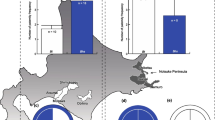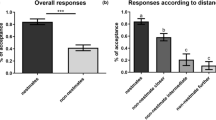Abstract
In many hymenopteran insect societies, selfish workers are policed, as selfishness can negatively affect the average inclusive fitness of one or both castes by reducing either the degree of average relatedness to the colony's male offspring or colony efficiency. In stingless bees, the rapid capping of brood cells could aid in controlling selfishness; to this end, we studied cell-sealing efficacy in Melipona bicolor. Execution of cell sealing was found to be both rapid and almost continuous. Comparing the performance of reproductive and non-reproductive workers, the former sealed the cells more efficiently when they contained their own eggs, but less so when the queens' eggs were involved. We argue that the occurrence of disruptions in cell sealing through self-serving reproductive workers is capable of undermining sealing efficacy as a policing instrument, thus making reproductive workers potential rogue individuals.




Similar content being viewed by others
References
Alves, D.A., Imperatriz-Fonseca, V.L., Francoy, T.M., Santos-Filho, P.S., Nogueira-Neto, P., Billen, J., Wenseleers, T. (2009) The queen is dead—long live the workers: intraspecific parasitism by workers in the stingless bee Melipona scutellaris. Mol. Ecol. 18, 4102–4111
Avila, B., Moo-Valle, H., Valladares, P., Camposeco, F., Quezada-Euán, J.J.G. (2005) Descripción del proceso de aprovisionamiento y oviposición en colonias de Melipona beecheii (Apidae:Meliponini) reporte de investigación, opción apicultura. FMVZ-Universidad Autónoma de Yucatán, Maestría en Producción Animal Tropical
Beig, D., Sakagami, S.F. (1964) Behavior studies of the stingless bees, with special reference to the oviposition process II. Melipona seminigra merrillae Cookerell. Ann. Zool. Jap. 37, 112–119
Cepeda, O.I. (2006) Division of labor during brood production in stingless bees with special reference to individual participation. Apidologie 37, 175–190
Cole, B.J. (1986) The social behavior of Leptothorax allardycei (Hymenoptera, Formicidae): time budgets and the evolution of worker reproduction. Behav. Ecol. Sociobiol. 18, 165–173
Evans, J.D. (1998) Parentage and sex allocation in the facultatively polygynous ant Myrmica tahoensis. Behav. Ecol. Sociobiol. 44, 35–42
Foster, K.R., Gulliver, J., Ratnieks, F.L.W. (2002) Worker policing in the European hornet Vespa crabro. Insectes Soc. 49, 41–44
Hammond, R.L., Keller, L. (2004) Conflict over male parentage in social insects. PLoS Biol. 2(9), e248
Hammond, R.L., Bruford, M.W., Bourke, A.F.G. (2003) Male parentage does not vary with colony kin structure in a multiple-queen ant. J. Evol. Biol. 16, 446–455
Hillesheim, E., Koeniger, N., Moritz, R.F.A. (1989) Colony performance in Honeybees (Apis mellifera capensis Esch.) depends on the proportion of subordinate and dominant workers. Behav. Ecol. Sociobiol. 24, 291–296
Kerr, W.E. (1962) Genetics of sex determination. Annu. Rev. Entomol. 7, 157–176
Kistner, D.H. (1982) The social insects' bestiary. In: Hermann, H.R. (ed.) Social insects, vol. III, pp. 2–244. Academic Press, New York
Koedam, D. (1999) Production of queens, workers and males in the stingless bee Melipona favosa (Apidae: Meliponinae): patterns in time and space. Neth. J. Zool. 49, 289–302
Koedam, D. (2003) A non-invasive method for sampling Melipona brood combs and determining caste and sex ratios. In: Melo, G.A.R., Alves-dos-Santos, I. (eds.) Apoidea neotropica: Homenagem aos 90 anos de Jesus Santiago Moure, pp. 153–156. Editora UNESC, Criciúma
Koedam, D., Contrera, F.A.L., Imperatriz-Fonseca, V.L. (1999) Clustered male production by workers in the stingless bee Melipona subnitida Ducke (Apidae: Meliponinae). Insectes Soc. 46, 387–391
Koedam, D., Contrera, F.A.L., Fidalgo, A.O., de Imperatriz-Fonseca, V.L. (2005) How queen and workers share in male production in the stingless bee Melipona subnitida (Apidae, Meliponini). Insectes Soc. 52, 114–121
Koedam, D., Cepeda Aponte, O.I., Imperatriz-Fonseca, V.L. (2007) Egg laying and oophagy by reproductive workers in the polygynous stingless bee Melipona bicolor (Hymenoptea, Meliponini). Apidologie 38, 55–66
Peters, J.M., Queller, D.C., Imperatriz-Fonseca, V.L., Roubik, D.W., Strassmann, J.E. (1999) Mate number, kin selection and social conflicts in stingless bees and honeybees. Proc. R. Soc. Lond. 266, 379–384
Pioker, F.C., Cepeda Aponte, O.I., Imperatriz-Fonseca, V.L. (2003) Specialization in workers of Melipona bicolor: the first discharger of larval food in the provisioning and oviposition process (POP). In: Melo, G.A.R., Alves-dos-Santos, I. (eds.) Apoidea neotropica: Homenagem aos 90 anos de Jesus Santiago Moure, pp. 163–169. Editora UNESC, Criciúma
Ratnieks, F.L.W. (1988) Reproductive harmony via mutual policing by workers in eusocial Hymenoptera. Am. Nat. 132, 217–236
Ratnieks, F.L.W., Anderson, C. (1999) Task partitioning in insect societies. Insectes Soc. 46, 95–108
Ratnieks, F.L.W., Reeve, H.K. (1992) Conflict in single-queen hymenopteran societies: the structure of conflict and processes that reduce conflict in advanced eusocial species. J. Theor. Biol. 158, 33–65
Robson, S.K., Traniello, J.F.A. (1999) Key individuals and the organisation of labor in ants. In: Detrain, C., Deneuborg, J.L., Pasteels, J.M. (eds.) Information processing in social insects, pp. 239–259. Birkhäuser Verlag, Basel
Ross, K.G. (1985) Aspects of worker reproduction in 4 social wasp species (Insecta, Hymenoptera, Vespidae). J. Zool. 205, 411–424
Sakagami, S.F. (1982) Stingless bees. In: Hermann, H.R. (ed.) Social insects, vol. III, pp. 361–424. Academic Press, New York
Sakagami, S.F., Oniki, Y. (1963) Behavior studies of the stingless bees, with special reference to the oviposition processs. I. Melipona compressipes manaosensis Schwarz, J. Fac. Sc., Hokk. Univ. Ser. VI. Zool. 16, 300–318
Sakagami, S.F., Zucchi, R. (1963) Oviposition process in a stingless bee, Trigona (Scaptotrigona) postica Latreille (Hymenoptera). Stud. Ent. 6, 497–510
Sakagami, S.F., Zucchi, R. (1967) Behavior studies of the stingless bee, with special reference to the oviposition process VI. Trigona (Tetragona) clavipes. J. Fac. Sc., Hokk. Univ. Ser.VI, Zool. 16, 292–313
Sakagami, S.F., Zucchi, R. (1968) Oviposition behaviour of an amazonic stingless bee, Trigona (Duckeola) ghilianii. J. Fac. Sci., Hokk. Univ. Ser. VI, Zool. 16, 564–581
Sakagami, S.F., Zucchi, R. (1974) Oviposition behavior of two dwarf stingless bees, Hypotrigona (Leurotrigona) muelleri and H. (Trigonisca) duckei, with notes on the temporal articulation of oviposition process in stingless bees. J. Fac. Sc., Hokk. Univ. Ser. VI, Zool. 19, 361–421
Sakagami, S.F., Beig, D., Kyan, C. (1964) Behavior studies of the stingless bees, with special reference to the oviposition process. IV. Cephalotrigona femorata (Smith). Kontyû 32, 464–471
Santos-Filho P. S., Alves D. A.,. Eterovic A., Imperatriz-Fonseca V.L., Kleinert A. de M.P. (2006) Numerical investment in sex and caste by stingless bees (Apidae: Meliponini): a comparative analysis, Apidologie 37, 207–221
Sommeijer, M.J., Beuvens, F.T., Verbeek, H.J. (1982) Distribution of labour among workers of Melipona favosa F.: construction and provisioning of brood cells. Insectes Soc 29, 222–237
Terada, Y. (1974) Contribuição ao estudo da regulação social em Leurotrigona muelleri e Frieseomelitta varia (Hymenoptera, Apidae). Universidade de São Paulo, São Paulo, Dissertação de Mestrado
Tóth, E., Queller, D.C., Imperatriz-Fonseca, V.L., Strassmann, J.E. (2002) Genetic and behavioural conflict over male production between workers and queens in the stingless bee Paratrigona subnuda. Behav. Ecol. Sociobiol. 53, 1–8
Tóth, E., Queller, D.C., Dollin, A., Strassmann, J.E. (2004) Conflict over male parentage in stingless bees. Insectes Soc. 51, 1–11
Trivers, R.L., Hare, H. (1976) Haplodiploidy and the evolution of social insects. Science 191, 249–263
Velthuis, H.W.W., Koedam, D., Imperatriz-Fonseca, V.L. (2005) The males of Melipona and other stingless bees, and their mothers. Apidologie 36, 169–185
Venturieri, G.C. (1991) Aspectos etológicos e descrição do ninho, macho e fêmea de Melipona puncticollis Friese, 1902 (Hymenoptera: Apidae). Dissertação de Mestrado, FFCLRP-USP, Riberão Preto
Wilson, E.O. (1971) The insect societies. Harvard Univ, Press, Cambridge, Massachusetts
Zucchi, R. (1993) Ritualised dominance, evolution of queen-worker interactions and related aspects in stingless bees (Hymenoptera: Apidae). In: Inoue, T., Yamane, S. (eds.) Evolution of insect societies, pp. 207–249. Hakuhin-sha Publishing Co., Tokyo
Acknowledgements
This research was supported by FAPESP (DK and VLIF). Hayo H. W. Velthuis is acknowledged for his valuable suggestions during the various stages of the M. bicolor project. We also thank Tom Wenseleers for his comments on earlier drafts of the manuscript, as well as Olga Cepeda for her cooperation in the observations. Special thanks go to Ramon A. Clark and David De Jong for linguistic advice and to anonymous reviewers for their comments that helped improving the manuscript.
Author information
Authors and Affiliations
Corresponding author
Additional information
Manuscript editor: Marla Spivak
Efficacité dans l’operculation des cellules et ouvrières pondeuses chez Melipona bicolor (Hymenoptera, Meliponini)
Abeilles sans aiguillon / Melipona bicolor / operculation des cellules / efficacité / ouvrières pondeuses
Zellverdeckelungseffizienz bei reproduktiven Arbeiterinnen der Stachellosen Biene Melipona bicolor : Doppelte Masstäbe und schurkenhaftes Verhalten
Stachellose bienen / Melipona bicolor / Zellverdeckelung / Effizienz / reproduktive Arbeiterinnen / Schurkisches verhalten
Rights and permissions
About this article
Cite this article
Koedam, D., Imperatriz-Fonseca, V.L. Cell-sealing efficiency and reproductive workers in the species Melipona bicolor (Hymenoptera, Meliponini): double standard and possible rogue conduct. Apidologie 43, 371–383 (2012). https://doi.org/10.1007/s13592-011-0111-z
Received:
Revised:
Accepted:
Published:
Issue Date:
DOI: https://doi.org/10.1007/s13592-011-0111-z




